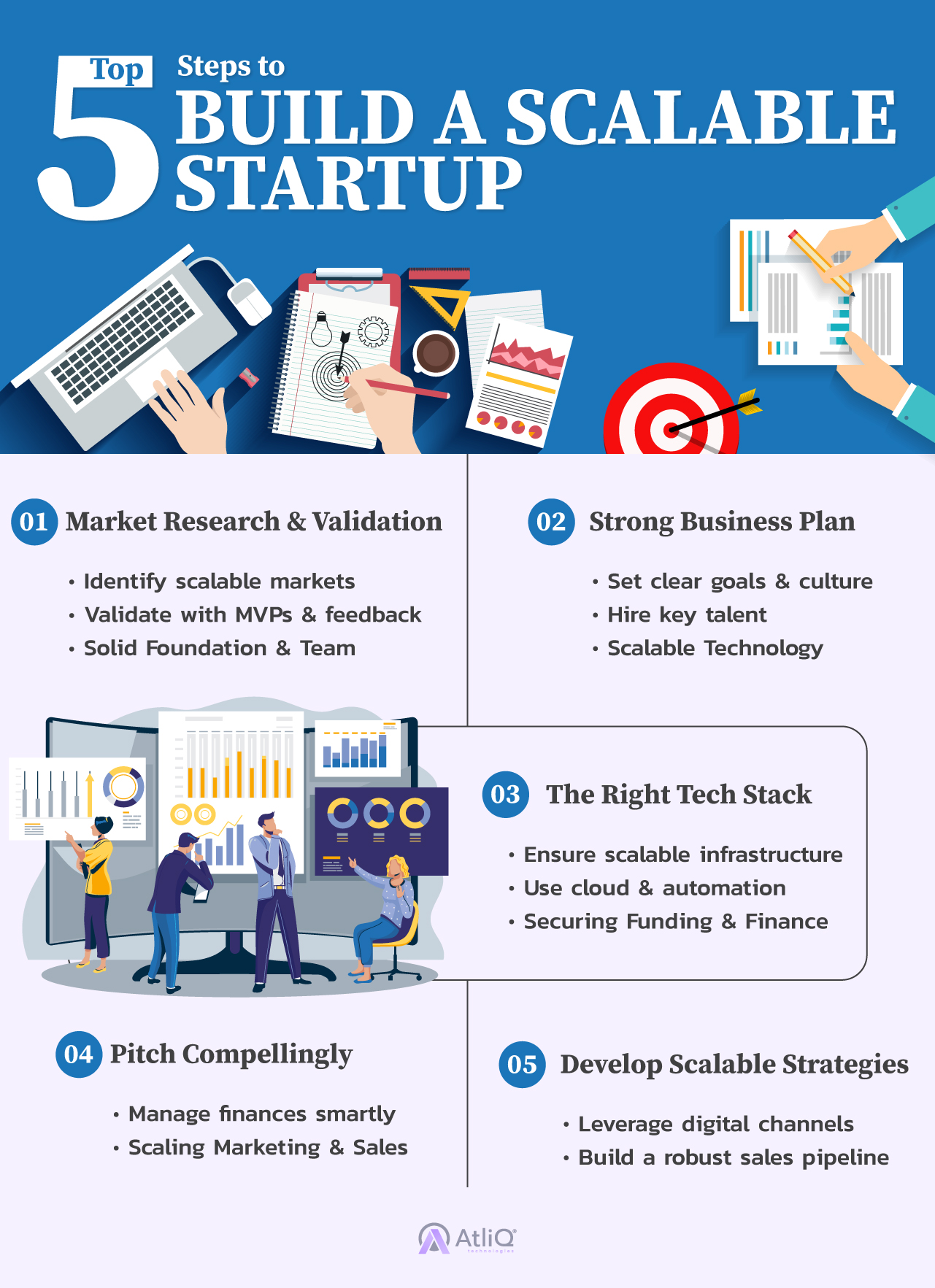
Picture this: You’re standing at the base of Mount Everest, staring up at its towering peak. Your dream? To not just climb it, but to build an entire city on its summit. Sounds impossible, right? Well, welcome to the world of scalable startups in 2024. Building a scalable startup isn’t just about reaching the top – it’s about constructing an empire that can withstand the thin air, unpredictable weather, and treacherous terrain of the business world. It’s about creating a venture that doesn’t just survive the climb but thrives at altitudes where others falter.
In this guide, we’re not just handing you a map and a compass. We’re equipping you with a state-of-the-art, AI-powered jet pack, complete with a built-in oxygen supply and a Swiss Army knife of business tools. Whether you’re a first-time founder or a serial entrepreneur, this step-by-step guide for 2024 will help you navigate the ever-changing landscape of startups. So, strap in and hold tight. We’re about to embark on a journey that will take your idea from sea level to stratosphere. Are you ready to build a startup that doesn’t just scale mountains, but moves them? Let’s begin our ascent to startup success!
What exactly is a scalable startup? It’s not just another buzzword in the entrepreneurial lexicon. At its core, a scalable startup is a business designed to grow exponentially without being hampered by its structure or available resources. A traditional business model stretches until it snaps under pressure. A scalable startup, however, is like a rubber band that magically produces more material as you pull it, growing stronger and larger without breaking.
Key characteristics of a scalable startup include:
- Replicable business model: The core offering can be reproduced and distributed widely without a proportional cost increase.
- Technology-driven: Often leverages cutting-edge tech to automate processes and reach a global audience.
- High growth potential: Capable of capturing a large market share rapidly.
- Efficient use of resources: Can increase revenue significantly without a corresponding rise in operational costs.
- Adaptability: Flexible enough to pivot and evolve with market demands.
In 2024, scalability isn’t just about handling increased workload—it’s about thriving under it. It’s the difference between a local food truck and a franchise-ready restaurant chain, or between a freelance coder and the next big SaaS company. Remember, not every successful business needs to be scalable, but every scalable business has the potential to disrupt industries and create massive value.
Market Research and Validation
Effective market research and validation are crucial for building a scalable startup. Here’s a streamlined approach:
Identifying a Scalable Market
- Industry Analysis: Examine industry reports and market trends to find sectors with significant demand and growth potential.
- Competitor Analysis: Analyze existing players to identify market gaps your startup can fill.
- Customer Segmentation: Break down the market into segments based on demographics and behavior to find underserved areas.
- Trend Spotting: Stay updated on emerging trends and technologies for a competitive edge.
Conducting Thorough Market Research
- Surveys & Questionnaires: Gather quantitative data on customer preferences and pain points.
- Interviews: Conduct in-depth interviews to gain qualitative insights into customer needs.
- Focus Groups: Use small groups to discuss perceptions and gather feedback.
- Secondary Research: Utilize existing research reports and market studies for additional context.
Validating Your Idea with a Minimum Viable Product (MVP)
- Identify Core Features: Focus on the most critical features that address your market’s primary needs.
- Develop the MVP: Build a functional MVP quickly and cost-effectively.
- Launch & Test: Release the MVP to a small target segment and monitor its performance.
Gathering and Analyzing Feedback
- User Feedback: Collect feedback through surveys, interviews, and analytics.
- Data Analysis: Analyze usage data to identify patterns and trends.
- Iterate & Improve: Use feedback to refine your product, making necessary adjustments.
- Continuous Feedback Loop: Regularly collect and analyze feedback to ensure your product evolves with market demands.
By thoroughly researching your market and validating your idea with an MVP, you establish a strong foundation for a scalable startup, minimizing risks and ensuring a better product-market fit.
Building a Strong Foundation and Team
Creating a solid foundation and assembling the right team is crucial for scaling your startup. Here’s how to get started:
Creating a Solid Business Plan
- Executive Summary: Brief overview of your mission and goals.
- Market Analysis: Research your industry, target market, and competitors.
- Business Model: Describe your products/services and revenue streams.
- Marketing and Sales Strategy: Outline customer acquisition and retention plans.
- Operational Plan: Detail daily operations, logistics, and resources.
- Financial Plan: Provide revenue projections, expenses, and funding needs.
Setting Clear, Achievable Goals and Milestones
Setting well-defined goals and milestones is crucial for tracking your progress and keeping your team focused.
- SMART Goals: Ensure your goals are Specific, Measurable, Achievable, Relevant, and Time-bound.
- Short-term and Long-term: Balance immediate objectives with long-term vision to maintain momentum and strategic direction.
- Milestones: Break down larger goals into smaller, manageable milestones to monitor progress and celebrate achievements.
Establishing a Strong Company Culture
- Core Values: Define and promote your company’s core values.
- Leadership: Lead by example to inspire your team.
- Communication: Foster transparency and open dialogue.
- Employee Engagement: Involve employees in decision-making and recognize contributions.
- Continuous Learning: Encourage professional development and continuous improvement.
Identifying Key Roles and Hiring the Right Talent
- Key Roles: Identify essential positions for growth (e.g., CTO, CMO, CFO).
- Skills and Fit: Seek candidates with the right skills and cultural alignment.
- Recruitment Strategy: Use job boards, social media, networking, and referrals.
- Interview Process: Assess technical skills, cultural fit, and growth potential.
- Onboarding: Implement a thorough onboarding program to integrate new hires.
By focusing on these key areas, your startup will be well-positioned to scale successfully and manage growth effectively.
Developing Scalable Technology
Developing scalable technology is essential for your startup’s growth. Here’s a concise guide on choosing the right technology stack, building robust infrastructure, following software development best practices, and leveraging cloud services and automation tools.
Choosing the Right Technology Stack
- Fit for Purpose: Align technologies with business needs.
- Scalability: Choose scalable languages and frameworks (e.g., Python, React).
- Community Support: Favor well-supported technologies.
- Flexibility: Ensure easy integration and future upgrades.
Ensuring Your Infrastructure Can Handle Growth
- Scalable Architecture: Use microservices or serverless architectures.
- Load Balancing: Distribute traffic evenly across servers.
- Monitoring and Alerts: Track performance and set up alerts.
- Redundancy and Failover: Ensure high availability with redundancy mechanisms.
Best Practices for Software Development and Maintenance
- Agile Methodologies: Implement Scrum or Kanban.
- Version Control: Use systems like Git.
- Code Reviews: Conduct regular reviews for quality.
- Testing: Implement automated unit and integration tests.
- CI/CD: Set up pipelines for continuous integration and deployment.
Securing Funding and Financial Management
Securing funding and managing finances are critical steps for scaling your startup. Here’s an overview of the various funding options, how to prepare a compelling pitch deck and best practices for financial planning and cash flow management.
Overview of Funding Options
- Venture Capital (VC): Provides significant capital in exchange for equity. Ideal for startups with high growth potential.
- Angel Investors: Wealthy individuals who invest their own money in early-stage startups, often in exchange for convertible debt or ownership equity.
- Crowdfunding: Raising small amounts of money from a large number of people, typically via online platforms like Kickstarter or Indiegogo.
- Government Grants and Loans: Non-dilutive funding options provided by government programs to support startups and small businesses.
- Bootstrapping: Using personal savings or revenue from the business to fund growth, avoiding external funding sources.
Preparing a Compelling Pitch Deck
- Introduction: Briefly introduce your startup and its mission.
- Problem: Clearly define the problem your startup solves.
- Solution: Explain your product or service and how it addresses the problem.
- Market Opportunity: Showcase the market size and potential for growth.
- Business Model: Detail how your startup will make money.
- Traction: Highlight key metrics, milestones, and achievements.
- Team: Introduce your team and their relevant experience.
- Financials: Provide an overview of your financial projections.
- Funding Ask: Clearly state how much funding you are seeking and what it will be used for.
Financial Planning and Management for Scalability
- Budgeting: Create detailed budgets that align with your growth strategy.
- Forecasting: Regularly update financial forecasts to reflect changing conditions and new information.
- Expense Management: Track and manage expenses to avoid overspending and ensure efficient use of resources.
- Revenue Streams: Diversify revenue streams to reduce dependency on a single source and increase financial stability.
Importance of Cash Flow Management
- Cash Flow Projections: Create projections to anticipate cash needs and avoid shortfalls.
- Invoice Management: Implement efficient invoicing practices to ensure timely payments from clients.
- Cost Control: Monitor and control costs to maintain a positive cash flow.
- Reserves: Maintain a cash reserve to manage unexpected expenses and emergencies.
By focusing on securing funding and effectively managing finances, your startup will be well-positioned to scale and sustain growth. Proper financial management ensures that you have the resources to seize opportunities and navigate challenges as they arise.
Scaling Marketing and Sales
Scaling your marketing and sales efforts is essential for accelerating growth and expanding your customer base. Here’s a streamlined guide on developing a scalable marketing strategy, leveraging digital channels, building a robust sales pipeline, and using analytics and KPIs effectively.
Developing a Scalable Marketing Strategy
- Define Audience: Identify and segment your target market personas.
- Value Proposition: Clearly communicate what makes your offering unique.
- Channels: Select effective channels like social media, content marketing, and email.
- Automation: Use marketing automation tools for efficiency and scalability.
- Campaigns: Create adaptable campaigns that can be replicated and adjusted easily.
Leveraging Digital Marketing Channels
- SEO and Paid Advertising: Optimize for search engines and use paid ads for targeted reach.
- Content Marketing: Produce valuable content to engage and educate your audience.
- Social Media: Utilize platforms to connect, share content, and promote your brand.
- Email Campaigns: Nurture leads and retain customers through personalized communication.
Building a Robust Sales Pipeline
- Lead Generation: Implement strategies to attract and capture leads effectively.
- Lead Qualification: Establish criteria to prioritize and focus efforts on high-potential leads.
- CRM System: Utilize a CRM to manage relationships and track interactions.
- Sales Process: Continuously optimize to shorten cycles and improve conversions.
- Sales Enablement: Equip your team with tools and training to enhance performance.
Importance of Analytics and KPIs
- Data-Driven Insights: Use analytics to understand performance and customer behavior.
- Key Metrics: Track KPIs such as conversion rates, CAC, CLTV, and sales velocity.
- ROI Analysis: Evaluate campaign effectiveness and allocate resources efficiently.
- Continuous Improvement: Learn from data to refine strategies and achieve better results.
Building a scalable startup in 2024 demands strategic foresight and deliberate execution. The essential steps outlined here — market research and validation, establishing a strong foundation and team, developing scalable technology, securing funding and managing finances wisely, and scaling marketing and sales efforts — form the core pillars of success. Embracing these steps as a continuous process of learning and adaptation equips startups to thrive amidst dynamic market conditions, positioning them for growth and longevity in the competitive landscape of 2024 and beyond.
Start Scaling Today!
